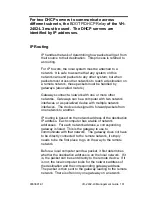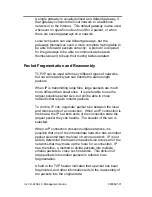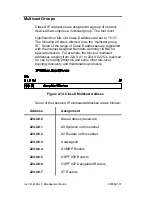
150
VH-2402-L3 Management Guide
9033691-01
TCP/IP
The TCP/IP protocol suite is a set of protocols that allow
computers to share resources across a network. TCP and
IP are only two of the Internet suite of protocols, but they are
the best known and it has become common to refer the
entire family of Internet protocols as TCP/IP.
TCP/IP is a layered set of protocols. An example, such as
sending e-mail, can illustrate this. There is first a protocol for
sending and receiving e-mail. This protocol defines a set of
commands to identify the sender, the recipient, and the
content of the e-mail. The e-mail protocol will not handle the
actual communication between the two computers, this is
done by TCP/IP. TCP/IP handles the actual sending and
receiving of the packets that make up the e-mail exchange.
TCP makes sure the e-mail commands and messages are
received by the appropriate computers. It keeps track of
what is sent and what is received, and retransmits any
packets that are lost or dropped. TCP also handles the
division of large messages into several Ethernet packets,
and makes sure these packets are received and
reassembled in the correct order.
Because these functions are required by a large number of
applications, they are grouped into a single protocol, rather
than being the part of the specifications for just sending e-
mail. TCP is then a library of routines that application
software can use when reliable network communications are
required.
IP is also a library of routines, but with a more general set of
functions. IP handles the routing of packets from the source
to the destination. This may require the packets to traverse
many different networks. IP can route packets through the
necessary gateways and provides the functions required for
any user on one network to communicate with any user on
another connected network.
The communication interface between TCP and IP is
relatively simple. When IP received a packet, it does not
know how this packet is related to others it has sent (or
received) or even which connection the packet is part of. IP
















































